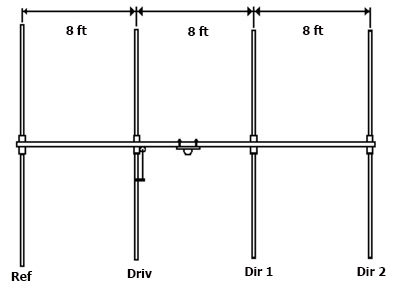Building a Dual-Band 2m/70cm Yagi Antenna: Tips, Formulas, and Pros and Cons
Building a Dual Band 2m/70cm Yagi Antenna: Tips, Formulas, and Pros and Cons
If you’re looking for a reliable and high-performing antenna for your 2m/70cm radio, a Yagi antenna might be just what you need. Yagi antennas are known for their directional properties, which can help you focus your transmission in a particular direction, resulting in better signal strength and clarity.
In this post, we’ll take a closer look at how you can build a dual-band 2m/70cm Yagi antenna, including the construction tips, formulas, and potential pros and cons of using this type of antenna.
Before we get started, it’s important to note that building a Yagi antenna requires some basic knowledge of antenna theory and construction, as well as some specialized tools and materials. If you’re new to antenna building, we recommend that you consult with an experienced ham radio operator or antenna builder before attempting to build your own.
What is a Yagi Antenna?
A Yagi antenna is a type of directional antenna that consists of a single driven element (the active part of the antenna that is connected to the transmission line), one or more reflector elements (passive elements that reflect the signal back towards the driven element), and one or more director elements (passive elements that help focus the signal in a particular direction). Yagi antennas are named after their inventor, Hidetsugu Yagi, a Japanese engineer who first developed the design in the 1920s.Yagi antennas are known for their high gain and directional properties, which can help improve the signal strength and clarity of your transmissions. However, Yagi antennas are typically more complex to build and require more precise tuning than other types of antennas, such as dipoles or verticals.
Formulas and Construction Tips
Building a dual-band 2m/70cm Yagi antenna requires some specialized tools and materials, as well as a basic understanding of antenna theory and construction. Here are the formulas and construction tips you’ll need to get started.
Formulas:
To determine the dimensions of your Yagi antenna, you’ll need to use some basic formulas to calculate the lengths of the driven, reflector, and director elements. Here are the formulas you’ll need to use:
Driven element: 468/frequency in MHz = length in feet
Reflector element: Driven element x 0.96 = length in feet
Director element: Driven element x 0.93 = length in feet
Construction Tips:
Here are some tips for constructing your dual-band 2m/70cm Yagi antenna:
Choose the right materials: Yagi antennas require specialized materials, such as aluminum tubing, stainless steel hardware, and a fiberglass or PVC boom. Make sure you choose materials that are appropriate for your frequency range and weather conditions.
Use a Yagi antenna calculator: There are many online calculators available that can help you determine the dimensions of your Yagi antenna based on your desired frequency range and gain. These calculators can save you time and ensure that your antenna is properly tuned.
Use a jig: To ensure that your Yagi antenna elements are properly spaced and aligned, it’s helpful to use a jig or template to hold the elements in place while you assemble the antenna.
Test and tune your antenna: Once you’ve assembled your Yagi antenna, it’s important to test and tune it to ensure that it is properly aligned and has the desired gain. Use an SWR meter and a signal analyzer to test your antenna and make any necessary adjustments.
Pros and Cons of Using a Dual Band 2m/70cm Yagi Antenna
While a dual-band 2m/70cm Yagi antenna can provide high gain and directional properties, there are also some potential pros and cons to consider before deciding to use this type of antenna.
Pros:
High gain: Yagi antennas are known for their high gain, which can help improve the signal strength and clarity of your transmissions.
Directional properties: Yagi antennas are directional, which means that they can focus your transmission in a particular direction, resulting in better signal strength and clarity.
Dual-band capabilities: A dual-band 2m/70cm Yagi antenna can provide coverage for both the 2m and 70cm bands, allowing you to use the same antenna for multiple frequencies.
Cons:
Complexity: Yagi antennas are typically more complex to build and require more precise tuning than other types of antennas, such as dipoles or verticals.
Narrow beamwidth: Because Yagi antennas are directional, they have a narrow beamwidth, which means that they may not be as effective in areas where the signal needs to be transmitted in multiple directions.
Limited coverage: While a Yagi antenna can provide high gain and directional properties, it may not be the best option for areas where you need to transmit over long distances or in multiple directions.
Conclusion
Building a dual-band 2m/70cm Yagi antenna can be a great way to improve the signal strength and clarity of your transmissions. However, it requires some specialized knowledge and tools, as well as careful tuning and testing to ensure that it is properly aligned and has the desired gain.
Before deciding to build a Yagi antenna, consider the potential pros and cons, and consult with an experienced ham radio operator or antenna builder if you have any questions or concerns. With the right tools and knowledge, a dual-band 2m/70cm Yagi antenna can be a powerful tool for improving your radio communications.


Comments
Post a Comment